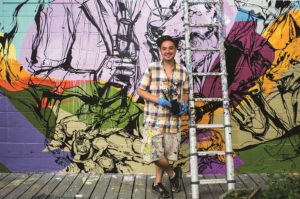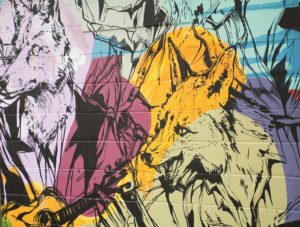EASTHAM — Two new works of art appeared along Route 6 last weekend — a large mural on the façade at the former Nickerson Service Center, and a smaller project on Jersey barriers at the T-Time property. Reactions were varied. Some were delighted, others dismayed, mistaking the bright paintings for unwanted graffiti.
mural
PUBLIC ART
A New Foundation Takes Art to the Streets
One of its first commissions is a mural by Esteban del Valle
Romolo Del Deo had an idea. In a town rich in art and art history, he thought that what Provincetown needed was even more art. Public art, to be exact.
The idea was to get it out of the galleries and onto the streets, where people could see it, without pretension. So, Del Deo, a sculptor, recruited like-minded people in the winter of 2020 to form a board, and asked curator and exhibition designer Samuel Tager to act as director. That’s how the nonprofit Provincetown Public Art Foundation was formed.

The board awarded its first three commissions to respected artists who have deep ties to the Outer Cape. Wellfleet sculptor Penelope Jencks will create a piece commemorating Mary Heaton Vorse that will be situated on the grounds of her historic home at 466 Commercial St. Jencks’s other works include the centerpiece to the Eleanor Roosevelt Memorial in New York’s Riverside Park and the statue of the historian Samuel Eliot Morison on Commonwealth Avenue in Boston.
A second commission will be executed by Provincetown artist and cartographer Mark Adams, who works for the Cape Cod National Seashore. “Mark proposed an absolutely brilliant mural project to be installed partially submerged on the marina bulkhead between the town’s two main piers,” Tager says. “This work will be designed to place Provincetown Harbor and Cape Cod Bay in the Gulf of Maine ecosystem. It will reflect the fact that Provincetown has become a vivid location to observe and bring awareness to climate change and sea level rise.”

The third commission is a mural by Esteban del Valle that he is currently painting on the western side of Marine Specialties at 235 Commercial St. The Chicago native has twice been a fellow at the Fine Arts Work Center and is represented by Albert Merola Gallery. He’s painted murals around the world — 32 solo ones are listed on his CV — including in and around his current home, Brooklyn, N.Y., throughout the United States, and in Colombia, the Dominican Republic, and Berlin.
“I grew up in Humboldt Park, which is primarily a Puerto Rican and African-American community in Chicago,” says del Valle. “The major exposure to art there was murals dealing with local history of the people and celebrating Puerto Rican history. But it also dealt with anti-gang violence and pro-education — all very message heavy. And graffiti. I have a clear memory of being in sixth grade in my mother’s car in the Ukrainian Village and there was an incredible mural. I was so amazed. I said, ‘I want to do that.’ I started drawing at an early age, but once I took on an artist’s identity, it was through graffiti art.”

The 60-by-12-foot Marine Specialties mural, Time and the Town, named after Vorse’s memoir, will depict anthropomorphized foxes at a dinner party in a dune shack. “Since returning to Provincetown, I’ve been seeing an abundance of foxes, more than I’ve ever seen before, and in ways that I’ve never seen them, like with food in their mouths,” says del Valle. During a conversation with Tager, del Valle learned that the species can never be fully domesticated: “Foxes seemed like a perfect metaphor for Provincetown,” says del Valle. “Like a fox, Provincetown will always be kind of wild.”
Because del Valle’s work tends to lean towards politics and satire, he also wanted to address the local housing shortage. “Provincetown has a great history of art, but the artists can’t afford to live here even casually, and neither can the servers or the fishermen,” he says. “I saw the dune shacks representing both the local history and the history of housing.”

The mural depicts a fox making repairs to the dune shack’s roof, which is exploding from being so overcrowded. A line of foxes, including a server and a fisherman, wait to get in. In the far distance, one can see another shack with another line of foxes, as well as the Mayflower.
At the far right, a wild fox sits next to an abandoned easel: an allusion to the disappearing artist.
